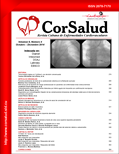Predictors of success of electrical cardioversion for atrial fibrillation
Abstract
Introduction: Electrical cardioversion is an effective therapeutic procedure to restore sinus rhythm in atrial fibrillation, and its success has been related to different variables.Objective: To relate clinical, electrical and echocardiographic variables to the success of electrical cardioversion for atrial fibrillation and to the amount of energy used to restore sinus rhythm.
Method: A prospective longitudinal study was conducted in 82 patients with atrial fibrillation who were treated with elective electrical cardioversion.
Results: Electrical cardioversion was successful in 81.7% of patients. Heart failure (p=0.000), mitral valve disease (p=0.001), previous arrhythmic events (p=0.005), increased time to progression (p=0.019), increased left ventricular telediastolic diameter (p=0.000), and increased diameter, area and pressure of the left atrium (p=0.000, p=0.008, p=0.000, respectively), were associated with a decrease in the success of the shock. Left ventricular ejection fraction was the only independent predictor of success (OR 2.1; 95% CI, p=0.048). The use of a higher amount of energy was related to previous arrhythmic events (p=0.000), decreased left ventricular ejection fraction (p=0.000), older age (p=0.037), increased time to progression (p=0.02), increased left ventricular diameter (p=0.000), increased diameter, area and pressure of the left atrium (p=0.000, p=0.000 and p=0.000, respectively) and increased area of the right atrium (p=0.016).
Conclusions: The left ventricular ejection fraction is an independent predictor of the success of electrical cardioversion for atrial fibrillation. The presence of biatrial remodeling, left ventricular dysfunction, previous arrhythmic events and a long progression require higher amounts of energy to restore sinus rhythm.
Downloads
Download data is not yet available.
Downloads
Published
2014-10-07
How to Cite
1.
Cruz Cardentey M, Pérez Rivera T, Méndez Rosaba A l. Predictors of success of electrical cardioversion for atrial fibrillation. CorSalud [Internet]. 2014 Oct. 7 [cited 2025 Nov. 8];6(4):280-7. Available from: https://revcorsalud.sld.cu/index.php/cors/article/view/115
Issue
Section
ORIGINAL ARTICLES
License
Authors who publish with this journal agree to the following terms:- Authors retain copyright and grant the journal right of first publication with the work simultaneously licensed under a Creative Commons Attribution License that allows others to share the work with an acknowledgement of the work's authorship and initial publication in this journal.
- Authors are able to enter into separate, additional contractual arrangements for the non-exclusive distribution of the journal's published version of the work (e.g., post it to an institutional repository or publish it in a book), with an acknowledgement of its initial publication in this journal.










